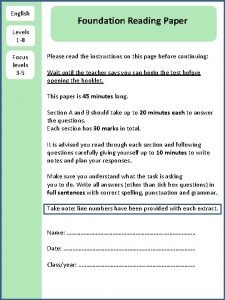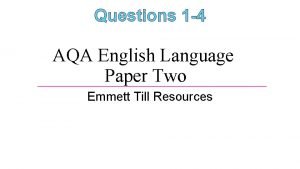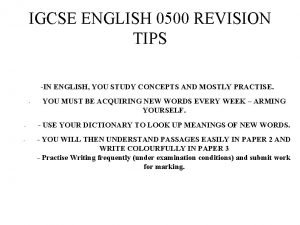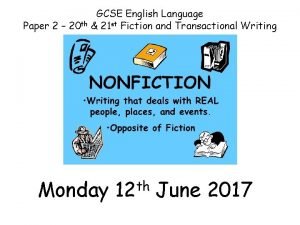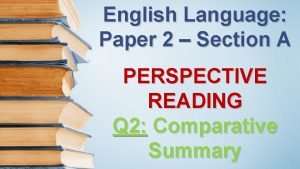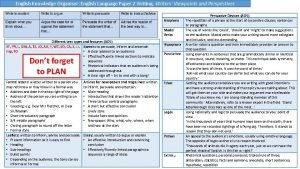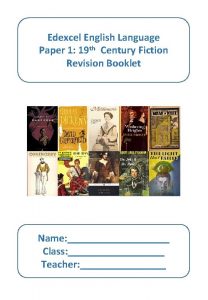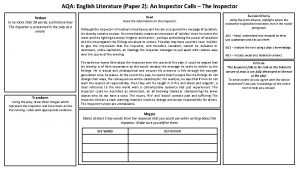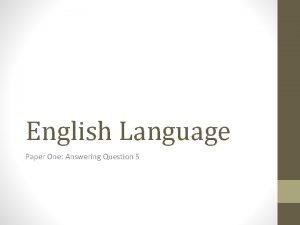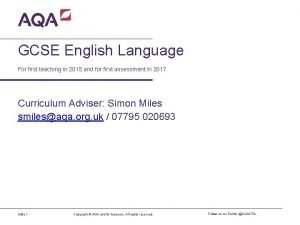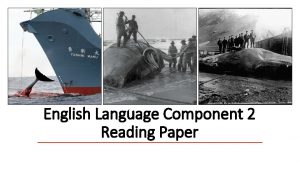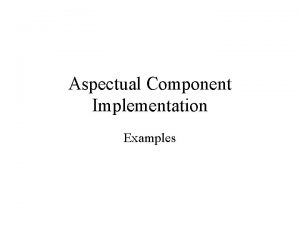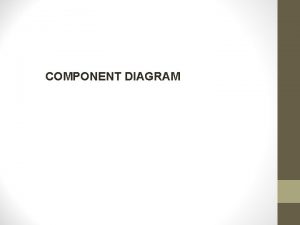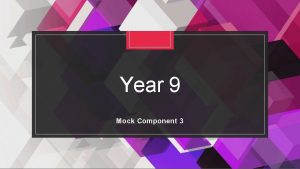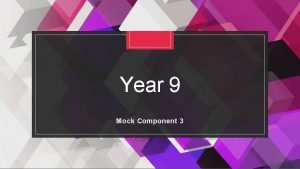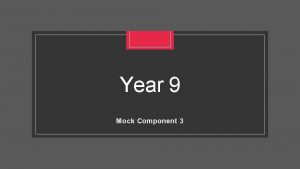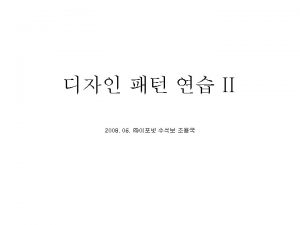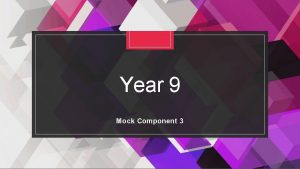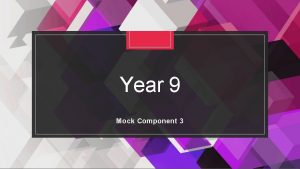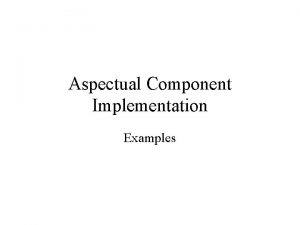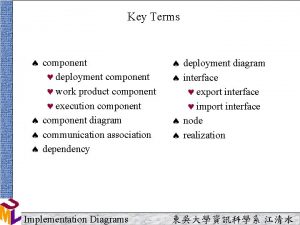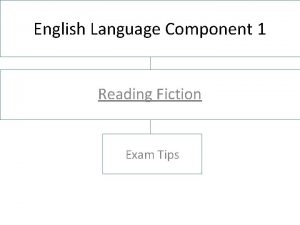English Language Component 2 Reading Paper What does






















- Slides: 22

English Language Component 2 Reading Paper

What does the reading section on English Language Component 2 paper look like? • You will be given two non-fiction articles. • One will be a modern article and the other will be an article from the 19 th century. • Both articles will be on the same or a similar subject. There always 6 questions. Questions 1 and 2 will be on one article. • Q 1 -‘locate and retrieve’ question – 3 marks. • Q 2 - ‘how’ question -10 marks. Questions 3 and 4 will be on the other article. • Q 3 ‘locate and retrieve’ question – 3 marks. • Q 4 ‘evaluate’ question – 10 marks. Questions 5 and 6 will be on both articles. • Q 5 – synthesise question – 4 marks. • Q 6 – comparison question – 10 marks.

Question 1 – locate and retrieve Tip – this should be 3 easy marks but it’s easy to make silly mistakes and lose marks . Make sure you read the correct article. Cotton Mills Paper The separate resource material for use with section A is a newspaper article, ‘The cotton in your clothes may be made by girls aged 11, paid just £ 6 a month ’ by Robin Pagna. Read the newspaper article by Robin Pagna. A 1. (a) How many days a week do the girls work in the spinning mills? [1] (b) How much might workers expect to be paid at the end of a contract? [1] (c) Name one British company that tries to insist on good conditions for cotton mill workers? (1) Read the question CAREFULLY. Underline what it is they’re asking you to look for in the article. The answers will be from any part of the article.

Question 1 answers • Award one mark for each correct response in (a), (b) and (c). • (a) 6 days a week (1) • (b) 40, 000 rupees (£ 400) or 35, 000 rupees (1) • (c) Primark or Mothercare (1)

Question 2 – How question Underline key words in the question. A 2. Robin Pagna is trying to persuade us that conditions in the cotton mills are “more like slavery”. How does he try to do this? You should comment on: what he says to influence readers his use of language and tone the way he presents his argument You need at least 7 different points from across the article. Point, short embedded quote, explain how it might persuade. [10]

Persuasive techniques • Putting forward an argument - this is about considering tactics used by writers to put across an argument. Match the tactic to the example. Example Tactic Anecdote or eyewitness evidence Physical injuries Emotive words “Forced to work relentless hours for pitiful wages in dangerous conditions. ”- The adjectives “relentless, ” “pitiful” and “dangerous” show the severity of the conditions for very little reward/poor wages told by Sara emphasises the long hours that the girls must work and the fact that it is like a “prison. ” Statistics and facts designed to shock “Girls as young as 11 are being paid as little as £ 6 a month” Use of shocked tone “terrible human violations of human rights of these girls on a huge scale, ” Call to action “suffered a permanent knee injury after being forced to stand without rest during months of gruelling night shifts. ” The final suggestion is that governments should be

Question 2 – How question How would I start? The writer uses a variety of methods to persuade the reader. Firstly, the opening statistic “Girls as young as 11” suggests that they are being taken advantage of because of their age. It also states that they “ are being paid as little as £ 6 a month” suggesting that their earnings are so poor that they are virtually slaves. Don’t waste time waffling. State a point, short embedded quote, say how it’s persuasive – move on!

Mark scheme Other areas you could have considered: • Opening statistic – “Girls as young as 11 are being paid as little as £ 6 a month” suggests their earnings are so poor they are virtually slaves • “Girls are sold to cotton spinning mills”- the verb “sold” suggests that they are seen as little more than a commodity • “Locked in for weeks on end”- the verb “locked” suggests the workers are imprisoned and held against their will • “Forced to work relentless hours for pitiful wages in dangerous conditions. ”- The adjectives “relentless, ” “pitiful” and “dangerous” show the severity of the conditions for very little reward/poor wages • The anecdote told by Sara emphasises the long hours that the girls must work and the fact that it is like a “prison. ” This results in the poor health of the girls, even leading to thoughts of suicide as the only way to escape • Many girls are signed up to three year contracts with the prospect of a lump sum on completion. Many quit because of the terrible conditions so only earn pitiful sums. This amounts to a form of “slavery. ” • Workers are not allowed phones, and can only go out once a month accompanied by guards • Physical injuries sustained by the harsh physical working conditions- “suffered a permanent knee injury after being forced to stand without rest during months of gruelling night shifts. ” • The girls are so desperate to escape that they will go to extreme measures- “one colleague died while jumping over the wall. ” The girls have to stand up all of the time they are at work Shocking statistics- “ 89 suicides and unexplained deaths. ” “Brutal conditions”- constant sound of the machines, heat and humidity The article ends with Pagna saying there are “terrible human violations of human rights of these girls on a huge scale, ” suggesting the conditions in the mills are shocking The final suggestion is that governments should be doing more to put an end to the `shocking exploitation` that goes on. The structure is to set out the issue, give specific details using anecdotes and first-person accounts and conclude with how the issue should now be dealt with – by shoppers’ increased awareness and by government action The tone is factual to reflect the seriousness and severity of the situation

Question 3 – locate and retrieve Tip – this should be 3 easy marks but it’s easy to make silly mistakes and lose marks . Make sure you read the correct article. Questions 3 and 4 are always on the second article. To answer the following questions you will need to read the extract by Friedrich Engels. A 3. (a) What causes the damage to girls’ health when they work in the rooms where cotton is turned into thread? [1] (b) Why is it easy for a worker to be caught up in the machinery belt? [1] (c) What does the writer mean when he says at the end of the passage: ‘it is like living in the midst of an army just returned from a war’? [1] Read the question CAREFULLY. Underline what it is they’re asking you to look for in the article. The answers will be from any part of the article.

Question 3 answers Award one mark for a correct response: (a) Cotton dust (1) (b) Because the belt has no safety guard (1) (c) The injuries of workers are so severe, they are comparable to those of war (1)

Question 4 – Evaluate question EVALUATE means to weigh up. These questions are asking your opinion. On this paper they might be worded in different ways: • What do you think and feel about the writer’s views? • The writer makes this sound dramatic and exciting. How far to do you agree? • How successful do you think the writer was in getting their view across?

Question 4 – Evaluate question Underline key words in the question. A 4. What do you think and feel about Friedrich Engels’ views about mill work? You should comment on: what is said how it is said [10] You must refer to the text to support your comments You need at least 7 different points from across the article. I think/ I feel/ I believe/ this makes me feel it is dramatic because. . / I think this is clear because….

How do I tackle this question? • Read the article. • What does the article make you think and feel? List your thoughts/feelings • How? • What does the writer tell us happens to the girls? • What words does he use?

Question 4 – EVALUATE question How would I start? Firstly, I think Friedrich Engels provides a horrifying description of the working conditions. He says some of the work in the mill can have “an especially injurious effect” leading to chest infections suggesting the health of workers is affected. Next, I believe he makes it clear that it is often `young girls` who are the victims of dreadful conditions in the mills which makes me feel sorry for them as they are children. Also, I think when he calls it a `gross injustice` that there is no escape from the effects of cotton dust he is showing his disgust at the unfairness of the situation. I feel that this disgust is further shown he points out that “The girl has no choice” implying that they are not being treated as humans who make their own choices. Carry on…. . . Don’t waste time waffling. State a point, use a quote, say why it’s clear and/or dramatic. Say I think/I feel for each point.

Mark scheme Other areas you could have considered: he lists the effects of dust - “awful blood-spitting, hard, and noisy breathing, pains in the chest, coughs, sleeplessness. ” he points out that the breathing of the cotton dust can lead to death he thinks the mill owners have scant regard for the health of the workers he emphasises the tortuous, physical impact of the work leading to deformity and stunted growth when he writes about the `poor girls`, he shows his concern for them he finds it “outrageous” that so many accidents that occur in the mills “A great multitude of accidents” suggests he is critical of the very high number of accidents in the mill. he implies that safety around the machines is not viewed as important by the mill owners he gives a vivid description of the way and the speed with which a fatal accident can occur “A great number of maimed ones may be seen going about in Manchester” suggests that the effects of the work in the mills are to be seen everywhere. It repeats the point that injuries are very common and frequently very severe Thoughts and feelings you could explore shock horror disbelief anger at the mill owners concern/sympathy for the workers

Question 5 – Synthesise question • Questions 5 and 6 ask you to use both articles to write your answers. • Question 5 is worth 4 marks and should be quite straightforward. The key is to make sure you look in both texts for the SPECIFIC thing they ask you to look for. To answer the following questions you will need to use both texts. A 5. What do the writers tell readers about the machinery used in the cotton mills? [4] YOU NEED TWO POINTS FROM EACH ARTICLE.

Question 5 – Synthesise question • What do we know about the machinery used in the cotton mills? Frederick Engels Robin Pagna • Some machinery spurts water over the workers when it is in operation • Working on the machines frequently leads to deformities • The machines are dangerous – they are the cause of terrible injuries and even deaths • The machines force the workers to stoop and bend – the machines are low • The workers have to stand – without rest - at the machines for very long periods • The machines operate 24 hours a day • The machines are very noisy – there is `constant clatter` • Working at the machines can lead to permanent injuries Example response Both texts explain that working on the machines can lead to permanent injuries, Pagna saying that one worker had a permanent knee injury as a result, whilst Engels gives examples of the permanent injuries and effects caused by long periods of working at the machines. Pagna says the machines are very noisy but Engels points out the extreme dangers involved in working with the machinery that can lead to deformities, injuries and even death.

Question 6 – Comparison question Which comparative connectives do you know? • When there are similarities: similarly also likewise this is similar to • When there are differences: however unlike conversely in contrast this is different to

Question 6 – Comparison question Underline key words in the question. Read question carefully. Which part of the modern Both of these texts are about workers in cotton mills. Compare the following: text should you be referring to in this question? A 6. the writers’ thoughts and feelings about the girls who work in cotton mills how the writers make their thoughts and feelings clear to readers [10] You must use the text to support your comments and make it clear which text you are referring to. This is very important. If you don’t do this – you will get 0 marks. You need at least 4 different comparison points from each article. Use comparative connectives ALL THE TIME! Say what the writers’ attitudes are and comment on how they use words to make their attitudes clear.

Question 6 – Comparison question How do I respond to this? Firstly, what are the two writers’ attitudes about the workers in the mills? Pagna Engels Thinks that the conditions are dangerous Thinks the conditions are dangerous He thinks they are treated like `slaves`, earning `pitiful wages in dangerous conditions`. He thinks the young girls are particularly susceptible to conditions brought about by the cotton dust. How do they get their points across? He uses emotive words like `slavery` to describe how the girls are treated. he makes a point of stressing these are `young` girls working in bad conditions. What else could we add?

Pagna he thinks they are treated like `slaves`, earning `pitiful wages in dangerous conditions` he thinks they are duped into signing long contracts that are worthless, despite promising good lump sums if completed – they are treated intolerably he can see that some take desperate measures to escape from the mills because the conditions are like being in a prison he thinks the girls have had their human rights violated he feels the girls are subjected to `terrible exploitation ` How they make their thoughts and feelings clear to the readers Pagna he uses emotive words like `slavery` to describe how the girls are treated he uses interviews with girls involved in the mill work to shock the reader he gives specific facts about the girls earnings to show little they earn he describes their conditions as `intolerable` to show his disgust the first-person accounts given by some of the girls are powerful and harrowing his use of adjectives make his views clear - `brutal conditions`, `gruelling night shifts` etc his descriptions of the mills `like prisons` shows his feelings about them Engels he thinks the young girls are particularly susceptible to conditions brought about by the cotton dust he implies it’s terrible that the girls have no choice but to work in dangerous conditions – they have `no choice` which he thinks is a `gross injustice` he feels that young girls are likely to develop chest infections / asthma – or worse he believes many of them have become deformed as a result of the work How they make their thoughts and feelings clear to the readers Engels he makes a point of stressing these are `young` girls working in bad conditions he details how they are affected by the work – he lists the ailments they suffer from he talks about them as `poor girls` showing his sympathy for their situation he writes about how easily they are maimed because of the poor conditions his description of their injuries is matter-of-fact but shocking nevertheless

Question 6 – Comparison question How do I set out my response? You have to compare in order to get marks and therefore it is best to make a point about one text and then a comparative point about the other text. What’s good about this? • Clearly states which article the information is from. • Uses evidence to back up points. • Comments on how the writer gets views across – through the words they use. • Uses comparative connectives. Model example Both articles point out the appalling conditions that the girls are forced to work in. Pagna uses emotive language to point out how he thinks they are treated like `slaves`, earning `pitiful wages in dangerous conditions`. Similarly, Engels also uses emotive language to imply how terrible it is that the girls have no choice but to work in dangerous conditions – they have `no choice` which he thinks is a `gross injustice` Carry on…
 Paper 2 aice general paper
Paper 2 aice general paper Jonathan and frances eduqas mark scheme
Jonathan and frances eduqas mark scheme English language component 2
English language component 2 Eduqas narrative writing titles
Eduqas narrative writing titles Pre reading while reading and post reading activities
Pre reading while reading and post reading activities English reading paper
English reading paper Aqa english language paper 1
Aqa english language paper 1 English language edexcel
English language edexcel English language paper 1 2021 june
English language paper 1 2021 june Igcse
Igcse Edexcel gcse english language paper 2
Edexcel gcse english language paper 2 Aqa english language paper 2 rail disasters model answers
Aqa english language paper 2 rail disasters model answers Brighton rock question 2 model answer
Brighton rock question 2 model answer Paper 1 fiction and imaginative writing
Paper 1 fiction and imaginative writing Language paper 2 knowledge organiser
Language paper 2 knowledge organiser English language paper 2 edexcel
English language paper 2 edexcel Edexcel literature paper 1 2022
Edexcel literature paper 1 2022 Edexcel english language paper 1 dracula
Edexcel english language paper 1 dracula English language igcse paper 1
English language igcse paper 1 Aqa english literature paper 2 2020 an inspector calls
Aqa english literature paper 2 2020 an inspector calls Language paper 1 question 1
Language paper 1 question 1 Language paper 1 question 5
Language paper 1 question 5 Homework has no value aqa model answer
Homework has no value aqa model answer





